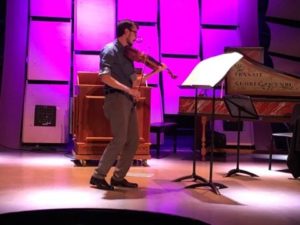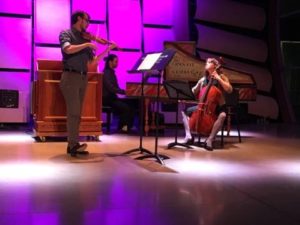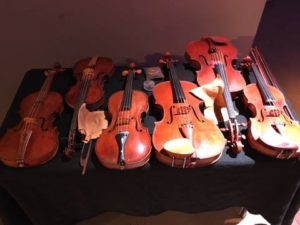 On Tuesday, October 18, 2016 at The Wild Beast on the Cal Arts campus, a faculty recital by Andrew McIntosh featured no fewer than six different violins and violas, five sections of the Rosary Sonatas with period Baroque tuning, four contemporary pieces, and two world premiers. A good-sized crowd turned out mid-week to experience a wide range of music employing tuning practices from the 16th to the 21st century.
On Tuesday, October 18, 2016 at The Wild Beast on the Cal Arts campus, a faculty recital by Andrew McIntosh featured no fewer than six different violins and violas, five sections of the Rosary Sonatas with period Baroque tuning, four contemporary pieces, and two world premiers. A good-sized crowd turned out mid-week to experience a wide range of music employing tuning practices from the 16th to the 21st century.
Embellie (1981) by Iannis Xenakis was first, a solo viola piece. Xenakis is quoted in the program notes: “I wrote this piece… trying to think only of the viola, with its low, beautiful notes and its particular voice lying in between those of the cello and the violin like a patch of more clement weather, a moment of calm during a storm…” The opening of Embellie was strongly assured, although perhaps tinged with a touch of anxiety, its complex texture and slight dissonances adding up to a sense of dissatisfaction. Lightly delicate phrases alternated with more forceful passages and McIntosh provided a finely controlled contrast in dynamics and color. At one point, a series of declarative phrases were succeeded by slow, continuously descending tones, unwinding like a far off siren. Rapid, skittering runs followed – requiring rock solid technique – and then some rougher, unsettled phrases that culminated in a high, wispy sound, like the soft whistling of the wind, as the piece quietly concluded.
Next was vla (2007) by Nicholas Deyoe. A version of this – vln – was written for violin, but this was the premiere performance for solo viola. Unlike the Xenakis piece that featured strong contrasts and a variety of textures, vla artfully occupied just a small subset of possible viola sounds. Deyoe noted that “The material is derived entirely from natural harmonics and pizzicato open strings on a retuned instrument.” Vla began with a continuous series of light, squeaky notes that floated insubstantially into the air, often leaving behind a questioning feel. The high, needle-like pitches were accompanied by similarly high pizzicato, deftly realized by the left hand of McIntosh, even as he bowed the arco parts. All of the familiar, rich tones of the viola were absent, but the dancing shimmer of pitches engaged the listener throughout. Vla convincingly evokes the hard sparkle of glass shards in a bright sunlight – from a most unlikely instrument.
A Memory of Perfection (2010) by Jürg Frey was next, and where the Deyoe work called for the piercingly high viola registers, the Frey piece was comprised of quiet, shadowy sounds, hovering somewhere between intonation and timbre in the solo violin. The low, sketchy notes were not fully formed tones, although the hint of an intended pitch was clearly audible. It was a bit like hearing air moving across a soda bottle just before it breaks into full oscillation – a sort of raspy whisper. This new texture was most effective in establishing a ghostly and mysterious feel – the aural equivalent of viewing a chiaroscuro sketch, or watching a cat stalking in the dark. This required a novel playing technique, and McIntosh remained in complete control of the sound as the piece progressed. A Memory of Perfection confronts us with the unexpected from the violin, challenging the expectations of the listener and opening intriguing new possibilities of gradation and nuance.
The final piece on the first half of the program was another world premiere, Etude II: “Vicentino & Gesualdo” (2014) by Wolfgang von Schweinitz. This is from the series of pieces titled Plainsound Etudes for viola solo, Op. 58b. Working with both new and historical alternate tuning, von Schweinitz writes: “Etude 2 also features the small chromatic semitone (with a frequency ratio of 25:24, i.e. circa 71 cents), which comes about in harmonic common-tone modulations into one of the upper or lower mediants, as already explored in the music of Nicola Vicentino and Don Carlo Gesualdo di Venosa.” Etude II began with a series of mournful notes and chords, all played cleanly on the viola by Mr. McIntosh. The long, sustained tones, often double-stopped, evoked a persuasive sense of sadness bordering on melancholy. Although occasionally more active rhythmically, this piece was mostly constant in its moderate tempo and pace. The tuning, although unconventional by modern standards, was perfectly suited to the overall mood. Etude II reaches across the centuries to rediscover a pensive wistfulness in this unexpectedly sophisticated Renaissance tuning practice.
After an intermission, the five sections of The Glorious Mysteries from the Rosary Sonatas (c. 1675) by Heinrich Ignatz Franz von Biber were performed. For this, Andrew McIntosh was joined by Heather Vorwerck on Baroque cello and Arthur Omura, playing harpsichord and organ. According to the program notes: “The Rosary Sonatas (often called the Mystery Sonatas) are a set of 15 sonatas and a solo violin passacaglia that depict the life of Christ through radical re-tunings of the violin. …Each sonata has its own unique character and mood created by the fact each one uses a different scordatura – the technique of tuning the open strings of the instrument to notes other than the customary ones, thus opening up possibilities for chords and resonances that would be impossible in standard tuning.” This involved quite a logistical effort as several different violins were employed and the players had to re-tune between each movement.
 Biber was a Bohemian in the German Catholic tradition and also a composer for the archbishop of Salzburg. The Glorious Mysteries begin with section XI. The Resurrection and continue onward with such spiritually triumphant events as XII. The Ascension, XIII. The Descent of the Holy Spirit, XIV. The Assumption of Mary into Heaven and finally, XV. The Coronation of Mary as Queen of Heaven and Earth. These displayed the various moods and feelings appropriate to each. For XI. The Resurrection, the violin was tuned with the two middle strings crossed, representing the crucifixion. A prelude-like beginning was followed by long descending scale (perhaps Christ’s descent to the dead) and then a strong chorale tune, complete with beautiful harmonies and a series of elegant variations. Section XIV. The Assumption of Mary into Heaven had a royal feel, dance-like as in a courtly procession. A series of dazzlingly rapid variations added a superlative and polished touch. Section XV. The Coronation of Mary as Queen of Heaven and Earth added pomp and grandeur as well as the sense of a summing up of the story. The phrasing was simple and sincere at first but as this section progressed, the passages increased in difficulty until waves of 32nd notes with a dizzying complexity poured out into the audience. All of this was expertly performed by McIntosh and the accompanying players – the various tunings and precision of the ensemble meshing together admirably.
Biber was a Bohemian in the German Catholic tradition and also a composer for the archbishop of Salzburg. The Glorious Mysteries begin with section XI. The Resurrection and continue onward with such spiritually triumphant events as XII. The Ascension, XIII. The Descent of the Holy Spirit, XIV. The Assumption of Mary into Heaven and finally, XV. The Coronation of Mary as Queen of Heaven and Earth. These displayed the various moods and feelings appropriate to each. For XI. The Resurrection, the violin was tuned with the two middle strings crossed, representing the crucifixion. A prelude-like beginning was followed by long descending scale (perhaps Christ’s descent to the dead) and then a strong chorale tune, complete with beautiful harmonies and a series of elegant variations. Section XIV. The Assumption of Mary into Heaven had a royal feel, dance-like as in a courtly procession. A series of dazzlingly rapid variations added a superlative and polished touch. Section XV. The Coronation of Mary as Queen of Heaven and Earth added pomp and grandeur as well as the sense of a summing up of the story. The phrasing was simple and sincere at first but as this section progressed, the passages increased in difficulty until waves of 32nd notes with a dizzying complexity poured out into the audience. All of this was expertly performed by McIntosh and the accompanying players – the various tunings and precision of the ensemble meshing together admirably.
The Glorious Mysteries provides a valuable insight into the extraordinary breadth of tuning practice and the high artistry of the Baroque period. Together with the first half of this concert it is remarkable how much of our contemporary thinking on alternate tuning was anticipated – and artfully realized – by the masters of the past.
(Photos by Jim Goodin – used with permission)

